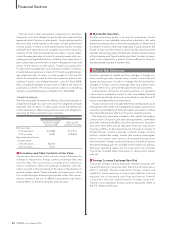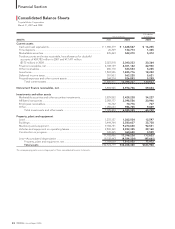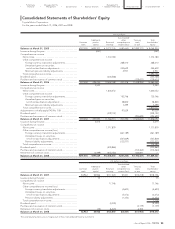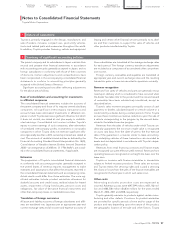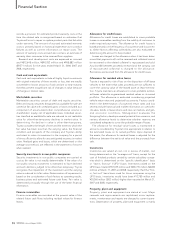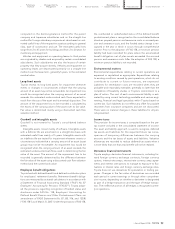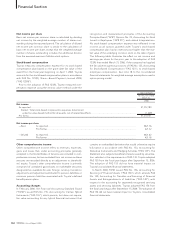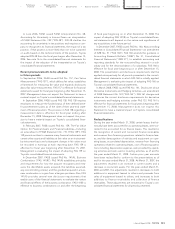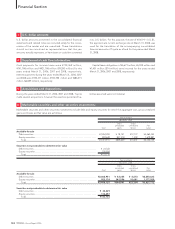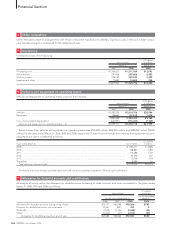Toyota 2008 Annual Report Download - page 102
Download and view the complete annual report
Please find page 102 of the 2008 Toyota annual report below. You can navigate through the pages in the report by either clicking on the pages listed below, or by using the keyword search tool below to find specific information within the annual report.
100 TOYOTA •Annual Report 2008 •
Financial Section
Other comprehensive income
Other comprehensive income refers to revenues, expenses,
gains and losses that, under accounting principles generally
accepted in the United States of America are included in com-
prehensive income, but are excluded from net income as these
amounts are recorded directly as an adjustment to sharehold-
ers’ equity. Toyota’s other comprehensive income is primarily
comprised of unrealized gains/losses on marketable securities
designated as available-for-sale, foreign currency translation
adjustments and adjustments attributed to pension liabilities or
minimum pension liabilities associated with Toyota’s defined
benefit pension plans.
Accounting changes
In February 2006, the Financial Accounting Standard Board
(“FASB”) issued FAS No. 155,
Accounting for Certain Hybrid
Instruments
(“FAS 155”), which permits, but does not require,
fair value accounting for any hybrid financial instrument that
contains an embedded derivative that would otherwise require
bifurcation in accordance with FAS No. 133,
Accounting for
Derivative Instruments and Hedging Activities
(“FAS 133”). The
Statement also subjects beneficial interests issued by securitiza-
tion vehicles to the requirements of FAS 133. Toyota adopted
FAS 155 from the fiscal year begun after September 15, 2006.
The adoption of FAS 155 did not have material impact on
Toyota’s consolidated financial statements.
In March 2006, FASB issued FAS No. 156,
Accounting for
Servicing of Financial Assets
(“FAS 156”), which amends FAS
No. 140,
Accounting for Transfers and Servicing of Financial
Assets and Extinguishments of Liabilities
(“FAS 140”), with
respect to the accounting for separately recognized servicing
assets and servicing liabilities. Toyota adopted FAS 156 from
the fiscal year begun after September 15, 2006. The adoption of
FAS 156 did not have material impact on Toyota’s consolidated
financial statements.
Net income per share
Basic net income per common share is calculated by dividing
net income by the weighted-average number of shares out-
standing during the reported period. The calculation of diluted
net income per common share is similar to the calculation of
basic net income per share, except that the weighted-average
number of shares outstanding includes the additional dilution
from the assumed exercise of dilutive stock options.
Stock-based compensation
Toyota measures compensation expense for its stock-based
compensation plan based on the grant-date fair value of the
award from the fiscal year beginning on April 1, 2006. Toyota
accounts for the stock-based compensation plans in accordance
with FAS No. 123(R),
Share—Based Payment (revised 2004)
(“FAS 123(R)”).
Prior to the adoption of FAS 123(R), Toyota measured com-
pensation expense using the intrinsic value method under the
recognition and measurement principles of the Accounting
Principles Board (“APB”) Opinion No. 25,
Accounting for Stock
Issued to Employees
(“APB 25”)
,
and related Interpretations.
No stock-based compensation expense was reflected in net
income, as all options granted under Toyota’s stock-based
compensation plan had an exercise price higher than the mar-
ket value of the underlying common stock on the date of grant.
The following table illustrates the effect on net income and
earnings per share for the prior year to the adoption of FAS
123(R) that ended March 31, 2006, if the company had applied
the fair value recognition provisions of FAS No. 123,
Accounting
for Stock-Based Compensation
(“FAS 123”), to stock-based
employee compensation. See note 18 to the consolidated
financial statements for weighted-average assumptions used in
option pricing model.
Yen in millions
For the year ended
March 31,
2006
Net income
As reported...................................................................................................................................................................................... ¥1,372,180
Deduct: Total stock-based compensation expenses determined
under fair value based method for all awards, net of related tax effects............................................................................. (1,449)
Pro forma.......................................................................................................................................................................................... ¥1,370,731
Net income per share
—Basic As reported ........................................................................................................................................................ ¥421.76
Pro forma.......................................................................................................................................................... 421.32
—Diluted As reported ........................................................................................................................................................ ¥421.62
Pro forma.......................................................................................................................................................... 421.18


